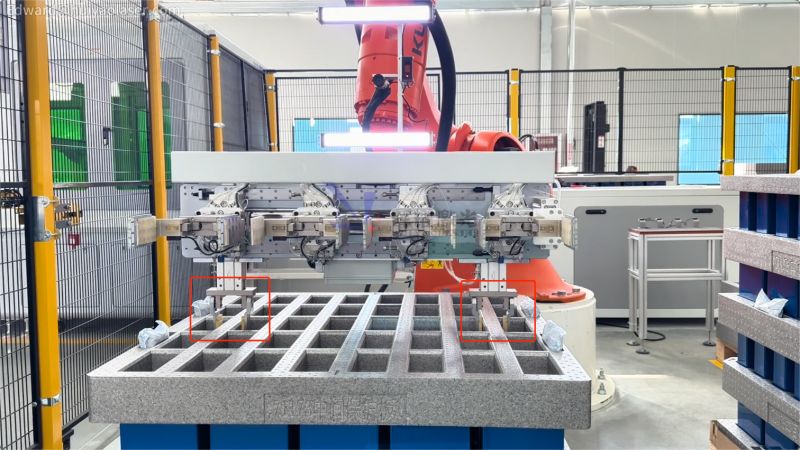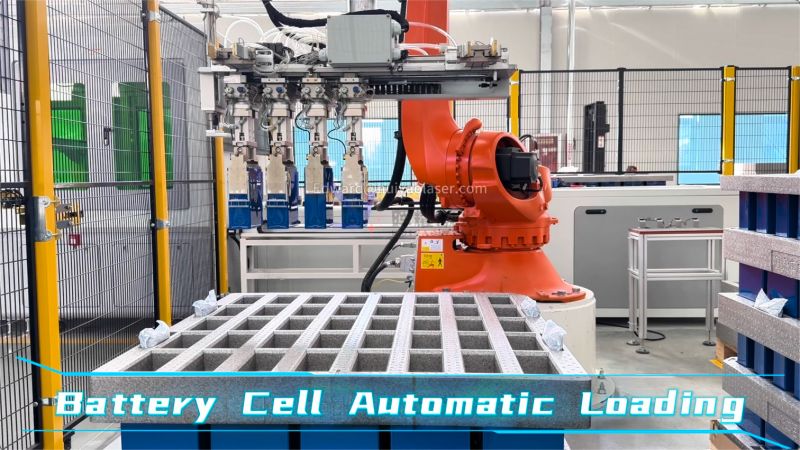Turnkey Solution for New Energy Intelligent Equipment
As the demand for Energy Storage Systems (ESS) grows exponentially, the need for efficient and reliable assembly processes for prismatic battery PACKs has become more critical than ever. A key step in this assembly line is the cell loading process, where precision and automation are essential to ensure consistent quality and high throughput. At the forefront of this innovation is the use of robotic arms in the cell loading station. This article highlights the critical role of robotic arms in automating the cell loading process for ESS battery PACK assembly.
The Importance of Cell Loading in Battery PACK Assembly

The cell loading station is one of the first and most vital stages in the prismatic battery PACK assembly process. This step involves transferring individual battery cells into the designated slots or compartments of the PACK housing. Proper alignment, secure placement, and careful handling are critical, as errors at this stage can compromise the performance and safety of the final product.
With manual processes, this step is not only time-consuming but also prone to human errors such as misalignment, inconsistent placement, or even accidental damage to the cells. Automation through robotic arms addresses these challenges by offering precision, repeatability, and efficiency.
Features of Robotic Arms in Cell Loading
Robotic arms used in the cell loading station are equipped with advanced technologies designed to handle delicate prismatic cells with care. Key features include:
1. High Precision Handling:
The robotic arms are programmed to pick and place cells with millimeter-level accuracy. This ensures perfect alignment and placement of each cell into the PACK structure, reducing the risk of assembly defects.
2. Adaptive Grippers:
Robotic arms are fitted with adaptive grippers or suction cups that can securely hold cells without applying excessive force. This minimizes the risk of mechanical damage during handling.
3. Integrated Vision Systems:
Many robotic arms are equipped with integrated cameras and vision systems that allow them to identify and verify cell orientation, ensuring that each cell is loaded correctly.
4. High-Speed Operation:
Advanced robotic systems can operate at high speeds without compromising accuracy. This significantly improves the overall throughput of the assembly line.
5. Safety Mechanisms:
Robotic arms are designed with collision detection and emergency stop features to prevent accidents and ensure the safety of operators and equipment.
The Cell Loading Process: Step-by-Step
The robotic arm cell loading process typically involves the following steps:
1. Cell Pickup:
The robotic arm retrieves a battery cell from a feeding station or storage rack. This step may involve vacuum suction or mechanical gripping, depending on the cell design.
2. Orientation Verification:
The integrated vision system checks the orientation and alignment of the cell to ensure it matches the required configuration for assembly.
3. Precise Placement:
The robotic arm places the cell into the designated slot within the PACK housing. This placement is guided by pre-programmed coordinates and real-time feedback from sensors.
4. Quality Check:
After placement, sensors verify that the cell is securely seated and correctly aligned. Any deviations trigger immediate corrections or alerts.
5. Repeat Process:
The robotic arm repeats the process for subsequent cells until the PACK is fully loaded.
Benefits of Using Robotic Arms for Cell Loading
The integration of robotic arms in the cell loading station offers several advantages:
1. Improved Precision and Consistency:
Robotic arms eliminate human variability, ensuring that every cell is loaded with the same level of precision.
2. Enhanced Efficiency:
High-speed operation allows robotic arms to complete the loading process faster than manual methods, increasing the overall throughput of the production line.
3. Reduced Risk of Damage:
Adaptive grippers and vision systems ensure that cells are handled delicately, reducing the risk of physical damage or misalignment.
4. Scalability:
Robotic systems can be easily reprogrammed or adjusted to accommodate different cell sizes and PACK designs, making them highly adaptable to changing production needs.
5. Cost Savings:
While the initial investment in robotic arms may be significant, the long-term cost savings from reduced labor, higher efficiency, and minimized defects make them a cost-effective solution.
Challenges and Considerations

Despite their numerous benefits, the use of robotic arms in cell loading is not without challenges. These include:
1. Initial Investment:
Robotic systems require a significant upfront investment in hardware, software, and integration.
2. Maintenance Requirements:
Regular maintenance and calibration are necessary to ensure optimal performance and longevity.
3. Training for Operators:
Operators must be trained to program and troubleshoot robotic systems, which may require additional resources.
Applications Beyond Cell Loading
The use of robotic arms extends beyond cell loading in the assembly line. They are also employed in other stages, such as welding, testing, and packaging, making them a versatile solution for automated battery PACK assembly.
About Huiyao Laser Technology (Luoyang) Co., Ltd.
Huiyao Laser Technology (Luoyang) Co., Ltd. is a leading provider of advanced manufacturing solutions, specializing in laser technologies and automation systems. With years of experience in the ESS industry, Huiyao offers cutting-edge robotic arm integration for battery PACK assembly lines. Their solutions are tailored to meet the specific needs of each client, ensuring high-quality, efficient, and reliable production processes.
Huiyao Laser’s expertise in automation and precision engineering makes them a trusted partner for companies looking to adopt state-of-the-art robotic systems for ESS battery PACK assembly.
280-Character Summary:
Explore how robotic arms transform prismatic battery PACK assembly with precision and speed. From adaptive grippers to integrated vision systems, robotic arms ensure flawless cell loading for ESS. Learn how automation boosts efficiency, reduces damage, and scales production seamlessly.

Email: yaolaser@huiyaolaser.com
Head Quarter Address: Huiyao Laser Technology, Building 2, Langxu Industrial Park, Guanlin Road, Science Park Street, Luolong District, Luoyang City, Henan Province, China
Research&Development Center: Room 901-9,Building B1, Phase 1, Southern Area, Baoneng Science and Technology Park, Qinghu Industrial Zone, Gangtou Community, Batian Street, Longgang District, Shenzhen City.